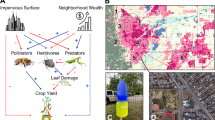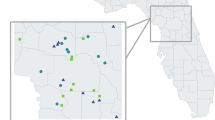This paper analyses the effect of microclimatic factors (internal soil temperature, surface temperature and surface relative humidity) on surface activity of Messor barbarus harvester ants. We selected 44 colonies in an area of Mediterranean grassland near Madrid (Central Spain), which were monitored for activity between March 1998 and September 1999. Results indicate that microclimatic factors are good predictors of colony activation and intensity of activity. Colonies became active above certain critical values of internal soil temperature and relative humidity. For active colonies, surface temperature was the main regulatory factor for worker departure rate, which peaked at around 25–30°C. Worker speed was positively correlated with surface temperature, although the relationship was weaker for large-sized workers. Microclimatic factors were not enough, however, to predict task allocation outside the nest. The explanation for this aspect of ant behavior probably requires the inclusion of biotic factors in the models.


Similar content being viewed by others
REFERENCES
Azcárate, F. M., Arqueros, L., Sánchez, A., and Peco, B. (2005). Seed and fruit selection by harvester ants Messor barbarus in Mediterranean grassland and scrubland. Funct. Ecol. 19: 273–284.
Azcárate, F. M., and Peco, B (2003). Spatial patterns of seed predation by harvester ants (Messor Forel) in Mediterranean grassland and scrubland. Insectes Sociaux 50: 120–126.
Azcárate, F. M., and Peco, B. (2004). Seed predation by ants (Messor spp.) in Iberian Dehesa grassland and scrubland. In Arianoutsou, M., and Papanastasis, V. P. (eds.), Ecology, Conservation and Management of Mediterranean Climate Ecosystems. Proceedings 10th MEDECOS Conference. Rhodes, Greece Millpress, Rotterdam, p. 42.
Bernstein, R. A. (1979). Schedules of foraging activity in species of ants. J. Anim. Ecol. 48: 921–930.
Briese, D. T., and Macauley, B. J. (1980). Temporal structure of an ant community in semi-arid Australia. Aust. J. Ecol. 5: 121–134.
Brown, M., and Gordon, D. M. (2000). How resources and encounters affect the distribution and foraging activity of a seed-harvesting ant. Behav. Ecol. Sociobiol. 47: 195–203.
Cerdá, X., and Retana, J. (1989). Influencia de los factores ambientales sobre la actividad diaria de recolección de la hormiga Cataglyphis iberica (Em.) (Hym.: Formicidae). Anales de Biología 15: 75–82.
Cerdá, X., and Retana, J. (1994). Food exploitation patterns of two sympatric seed-harvesting ants Messor bouvieri (Bond.) and Messor capitatus (Latr.) (Hym.: Formicidae) from Spain. J. Appl. Ent. 117: 268–277.
Cerdá, X., Retana, J., and Cros, S. (1997). Thermal disruption of transitive hierarchies in Mediterranean ant communities. J. Anim. Ecol. 66: 363–374.
Cerdá, X., Retana, J., and Cros, S. (1998a). Critical thermal limits in Mediterranean ant species: trade-off between mortality risk and foraging performance. Funct. Ecol. 12: 45–55.
Cerdá, X., Retana, J., and Manzaneda, A. (1998b). The role of competition by dominants and temperature in the foraging of subordinate species in Mediterranean ant communities. Oecologia 117: 404–412.
Challet, M., Jost, C., Grimal, A., Lluc, J., and Theraulaz, G. (2005). How temperature influences displacements and corpse aggregation behaviors in the ant Messor sancta. Insectes Sociaux. 52: 309–315.
Crist, T. O., and MacMahon, J. A. (1991). Foraging patterns of Pogonomyrmex occidentalis (Hymenoptera: Formicidae) in a shrub-steppe ecosystem: The roles of temperature, trunk trails, and seed resources. Environ. Entomol. 20: 37–46.
Crist, T. O., and MacMahon, J. A. (1992). Harvester ant foraging and shrubs-steppe seeds: Interactions of seed resources and seed use. Ecology 73: 1678–1779.
Crist, T. O., and Williams, J. A. (1999). Simulation of topographic and daily variation in colony activity of Pogonomyrmex occidentalis (Hymenoptera: Formicidae) using a soil temperature model. Environ. Entomol. 28: 659–668.
Cros, S., Cerdá, X., and Retana, J. (1997). Spatial and temporal variations in activity patterns of Mediterranean ant communities. Ecoscience 4: 269–278.
Detrain, C., Tasse, O., Versaen, M., and Pasteels, J. M. (2000). A field assessment of optimal foraging in ants: trail patterns and seed retrieval by the European harvester ant Messor barbarus. Insectes Sociaux 47: 56–62.
Díaz, M. (1991). Spatial patterns of granivorous ant nest abundance and nest site selection in agricultural landscapes of Central Spain. Insectes Sociaux 38: 351–363.
Díaz, M. (1992). Spatial and temporal patterns of granivorous ant seed predation in patchy cereal crop areas of central Spain. Oecologia 91: 561–568.
Feener, D. H., and Lighton, J. R. B. (1991). Is foraging in the desert ant, Messor pergandei (Hymenoptera: Formicidae), limited by water? Ecol. Entomol. 16: 183–191.
Fernandez-Escudero, I., and Tinaut, A. (1998). Heat-cold dialectic in the activity of Proformica longiseta, a thermophilous ant inhabiting a high mountain (Sierra Nevada, Spain). Int. J Biometerorol. 41: 175–182.
Gordon, D. M. (1983). Daily rhythms in social activities of the harvester ant, Pogonomyrmex badius. Psyche 90: 413–423.
Gordon, D. M. (1986). The dynamics of the daily round of the harvester ant colony (Pogonomyrmex barbatus). Anim. Behav. 34: 1402–1419.
Gordon, D. M. (1991). Behavioral flexibility and the foraging ecology of seed-eating ants. Am. Nat. 138: 379–411.
Gordon, D. M., and Mehdiabadi, N. J. (1999). Encounter rate and task allocation in harvester ants. Behav. Ecol. Sociobiol. 45: 370–377.
Hensen, I. (2002). Seed predation by ants in south-eastern Spain (Desierto de Tabernas, Almería). Anales de Biología 24: 89–96.
Hobbs, R. J. (1985). Harvester ant foraging and plant species distribution in annual grassland. Oecologia 67: 519–523.
Hölldobler, B., and Wilson, E. O. (1990). The Ants, Harvard University Press, Cambridge, Massachusetts.
Houston, A., Schmid-Hempel, P., and Kacelnik, A. (1988). Foraging strategy, worker mortality and the growth of the colony in social insects. Am. Nat. 131: 107–114.
Kaspari, M. (1993). Body-size and microclimate use in neotropical granivorous ants. Oecologia 96: 500–507.
Kaspari, M., and Weiser, M. D. (2000). Ant activity along moisture gradients in a neotropical forest. Biotropica 32: 703–711.
Lighton, J. R. B., Quinlan, M. C., and Feener, D. H. (1994). Is bigger better? – Water-balance in the polymorphic desert harvester ant Messor pergandei. Physiol. Entomol. 19: 325–334.
López, F., Serrano, J. M., and Acosta, F. J. (1992a). Temperature-vegetation structure interaction: The effect on the activity of the ant Messor barbarus (L.). Vegetatio 99–100: 119–128.
López, F., Serrano, J. M., and Acosta, F. J. (1992b). Intense reactions of recruitment facing unusual stimuli in Messor barbarus (L.). Dtsch. Ent. Z., N. F. 39: 135–142.
López, F., Acosta, F. J., and Serrano, J. M. (1993a). Foraging territories and crop production of a Mediterranean harvester ant in a grassland ecosystem. Acta Oecologica 14: 405–414.
López, F., Acosta, F. J., and Serrano, J. M. (1993b). Responses of the trunk routes of a harvester ant to plant density. Oecologia 93: 109–113.
MacKay, W. P. (1982). The effect of predation of western widow spiders (Araneae: Theridiidae) on harvester ants (Hymenoptera: Formicidae). Oecologia 53: 406–411.
Melhop, P., and Scott, N. J., Jr. (1983). Temporal patterns of seed use and availability in a guild of desert ants. Ecol. Entomol. 8: 69–85.
Morehead, S. A., and Feener, D. H. (1998). Foraging behavior and morphology: seed selection in the harvester ant genus, Pogonomyrmex. Oecologia 114: 548–555.
Morrison, L. W., Kawazoe, E. A., Guerra, R., and Gilbert, L. E. (2000). Ecological interactions of Pseudacteon parasitoids and Solenopsis ant hosts: environmental correlates of activity and effects on competitive hierarchies. Ecol. Entomol. 25: 433–444.
Nielsen, M. G., and Baroni-Urbani, C. (1990). Energetics and foraging behaviour of the European seed harvesting ant Messor capitatus. I. Respiratory metabolism and energy consumption of unloaded and loaded workers during locomotion. Physiol. Entomol. 15: 441–448.
Pol, P., and de Casenave, J. L. (2004) Activity patterns of harvester ants Pogonomyrmex pronotalis and Pogonomyrmex rastratus in the Central Monte Desert, Argentina. J. Ins. Beh. 17: 647–661.
Retana, J., and Cerdá, X. (2000). Patterns of diversity and composition of Mediterranean ground ant communities tracking spatial and temporal variability in thermal environment. Oecologia 123: 436–444.
Reyes-Lopez, J. L., and Fernandez-Haeger, J. (2001). Some factors determining size-matching in the harvester ant Messor barbarus: food type, transfer activity, recruitment rate and size-range. Insectes Sociaux 48: 118–124.
Reyes-Lopez, J. L., and Fernandez-Haeger, J. (2002a). Food storage in the nest and seed selectivity in the harvester ant Messor barbarus (Hymenoptera: Formicidae). Sociobiology 39: 123–128.
Reyes-López, J. L., and Fernández-Haeger, J. (2002b). Composition-dependent & density-dependent seed removal rates in the harvester ant Messor barbarus. Sociobiology 39: 1–10.
Rissing, S. W. (1982). Foraging velocity of seed-harvester ants, Veromessor pergandei. Environ. Entomol. 11: 905–907.
Sanders, N. J., and Gordon, D. M. (2000). The effects of interspecific interactions on resource use and behavior in a desert ant. Oecologia 125: 436–443.
Sanders, N. J., and Gordon, D. M. (2002). Resources and the flexible allocation of work in the desert ant, Aphaenogaster cockerelli. Insectes Sociaux 49: 371–379.
Sheata, M. N., and Kaschef, A. H. (1971). Foraging activities of Messor aegyptiacus. Insect. Soc. 18: 215–226.
Statsoft, Inc. (1998) STATISTICA for Windows (Computer program manual), StatSoft, Inc., Tulsa, Oklahoma
Vogt, J. T., Smith, W. A., Grantham, R. A., and Wright, R. E. (2003). Effects of temperature and season on foraging activity of red imported fire ants (Hymenoptera: Formicidae) in Oklahoma. Environ. Entomol. 323: 447–451.
Whitford, W. G. (1978). Foraging in seed harvester ants Pogonomyrmex spp. Ecology 59: 185–189.
Whitford, W. G., and Ettershank, G. (1975). Factors affecting foraging activity in Chihuahuan desert harvester ants. Environ. Entomol. 4: 689–696.
Wirth, R., and Leal, I. R. (2001). Does rainfall affect temporal variability of ant protection in Passiflora coccinea? Ecoscience 8: 450–453.
Zar, J. H. (1996). Biostatistical Analysis, 3rd edition, Prentice-Hall, New Jersey, p. 662.
ACKNOWLEDGEMENTS
This study was supported by the Spanish Ministry of Science and Technology (projects AMB 990382 and REN 2003-01562) and the Spanish Ministry of Education and Culture (FPI scholarship to F.M. Azcárate).
Author information
Authors and Affiliations
Corresponding author
Rights and permissions
About this article
Cite this article
Azcárate, F.M., Kovacs, E. & Peco, B. Microclimatic Conditions Regulate Surface Activity in Harvester Ants Messor barbarus . J Insect Behav 20, 315–329 (2007). https://doi.org/10.1007/s10905-007-9074-3
Accepted:
Published:
Issue Date:
DOI: https://doi.org/10.1007/s10905-007-9074-3




